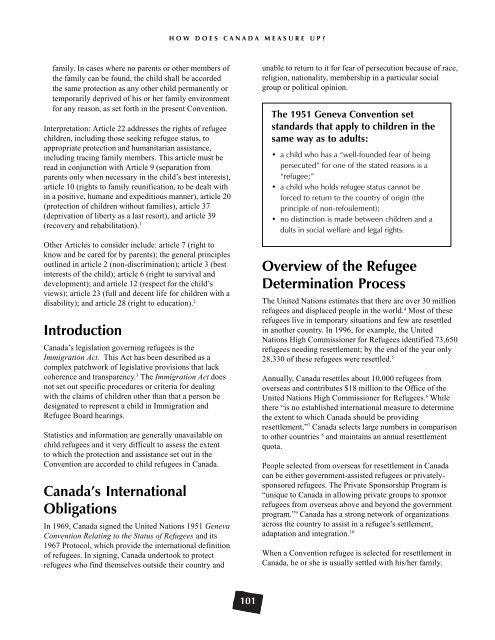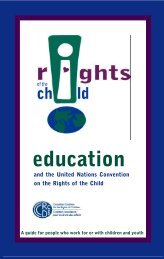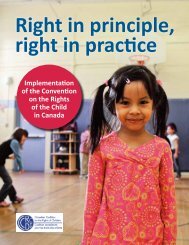Poste - Canadian Coalition for the Rights of Children
Poste - Canadian Coalition for the Rights of Children
Poste - Canadian Coalition for the Rights of Children
Create successful ePaper yourself
Turn your PDF publications into a flip-book with our unique Google optimized e-Paper software.
family. In cases where no parents or o<strong>the</strong>r members <strong>of</strong><br />
<strong>the</strong> family can be found, <strong>the</strong> child shall be accorded<br />
<strong>the</strong> same protection as any o<strong>the</strong>r child permanently or<br />
temporarily deprived <strong>of</strong> his or her family environment<br />
<strong>for</strong> any reason, as set <strong>for</strong>th in <strong>the</strong> present Convention.<br />
Interpretation: Article 22 addresses <strong>the</strong> rights <strong>of</strong> refugee<br />
children, including those seeking refugee status, to<br />
appropriate protection and humanitarian assistance,<br />
including tracing family members. This article must be<br />
read in conjunction with Article 9 (separation from<br />
parents only when necessary in <strong>the</strong> child’s best interests),<br />
article 10 (rights to family reunification, to be dealt with<br />
in a positive, humane and expeditious manner), article 20<br />
(protection <strong>of</strong> children without families), article 37<br />
(deprivation <strong>of</strong> liberty as a last resort), and article 39<br />
(recovery and rehabilitation). 1<br />
O<strong>the</strong>r Articles to consider include: article 7 (right to<br />
know and be cared <strong>for</strong> by parents); <strong>the</strong> general principles<br />
outlined in article 2 (non-discrimination); article 3 (best<br />
interests <strong>of</strong> <strong>the</strong> child); article 6 (right to survival and<br />
development); and article 12 (respect <strong>for</strong> <strong>the</strong> child’s<br />
views); article 23 (full and decent life <strong>for</strong> children with a<br />
disability); and article 28 (right to education). 2<br />
Introduction<br />
Canada’s legislation governing refugees is <strong>the</strong><br />
Immigration Act. This Act has been described as a<br />
complex patchwork <strong>of</strong> legislative provisions that lack<br />
coherence and transparency. 3 The Immigration Act does<br />
not set out specific procedures or criteria <strong>for</strong> dealing<br />
with <strong>the</strong> claims <strong>of</strong> children o<strong>the</strong>r than that a person be<br />
designated to represent a child in Immigration and<br />
Refugee Board hearings.<br />
Statistics and in<strong>for</strong>mation are generally unavailable on<br />
child refugees and it very difficult to assess <strong>the</strong> extent<br />
to which <strong>the</strong> protection and assistance set out in <strong>the</strong><br />
Convention are accorded to child refugees in Canada.<br />
Canada’s International<br />
Obligations<br />
In 1969, Canada signed <strong>the</strong> United Nations 1951 Geneva<br />
Convention Relating to <strong>the</strong> Status <strong>of</strong> Refugees and its<br />
1967 Protocol, which provide <strong>the</strong> international definition<br />
<strong>of</strong> refugees. In signing, Canada undertook to protect<br />
refugees who find <strong>the</strong>mselves outside <strong>the</strong>ir country and<br />
H O W D O E S C A N A D A M E A S U R E U P ?<br />
101<br />
unable to return to it <strong>for</strong> fear <strong>of</strong> persecution because <strong>of</strong> race,<br />
religion, nationality, membership in a particular social<br />
group or political opinion.<br />
The 1951 Geneva Convention set<br />
standards that apply to children in <strong>the</strong><br />
same way as to adults:<br />
• a child who has a “well-founded fear <strong>of</strong> being<br />
persecuted” <strong>for</strong> one <strong>of</strong> <strong>the</strong> stated reasons is a<br />
“refugee;”<br />
• a child who holds refugee status cannot be<br />
<strong>for</strong>ced to return to <strong>the</strong> country <strong>of</strong> origin (<strong>the</strong><br />
principle <strong>of</strong> non-refoulement);<br />
• no distinction is made between children and a<br />
dults in social welfare and legal rights.<br />
Overview <strong>of</strong> <strong>the</strong> Refugee<br />
Determination Process<br />
The United Nations estimates that <strong>the</strong>re are over 30 million<br />
refugees and displaced people in <strong>the</strong> world. 4 Most <strong>of</strong> <strong>the</strong>se<br />
refugees live in temporary situations and few are resettled<br />
in ano<strong>the</strong>r country. In 1996, <strong>for</strong> example, <strong>the</strong> United<br />
Nations High Commissioner <strong>for</strong> Refugees identified 73,650<br />
refugees needing resettlement; by <strong>the</strong> end <strong>of</strong> <strong>the</strong> year only<br />
28,330 <strong>of</strong> <strong>the</strong>se refugees were resettled. 5<br />
Annually, Canada resettles about 10,000 refugees from<br />
overseas and contributes $18 million to <strong>the</strong> Office <strong>of</strong> <strong>the</strong><br />
United Nations High Commissioner <strong>for</strong> Refugees. 6 While<br />
<strong>the</strong>re “is no established international measure to determine<br />
<strong>the</strong> extent to which Canada should be providing<br />
resettlement,” 7 Canada selects large numbers in comparison<br />
to o<strong>the</strong>r countries 8 and maintains an annual resettlement<br />
quota.<br />
People selected from overseas <strong>for</strong> resettlement in Canada<br />
can be ei<strong>the</strong>r government-assisted refugees or privatelysponsored<br />
refugees. The Private Sponsorship Program is<br />
“unique to Canada in allowing private groups to sponsor<br />
refugees from overseas above and beyond <strong>the</strong> government<br />
program.” 9 Canada has a strong network <strong>of</strong> organizations<br />
across <strong>the</strong> country to assist in a refugee’s settlement,<br />
adaptation and integration. 10<br />
When a Convention refugee is selected <strong>for</strong> resettlement in<br />
Canada, he or she is usually settled with his/her family.




